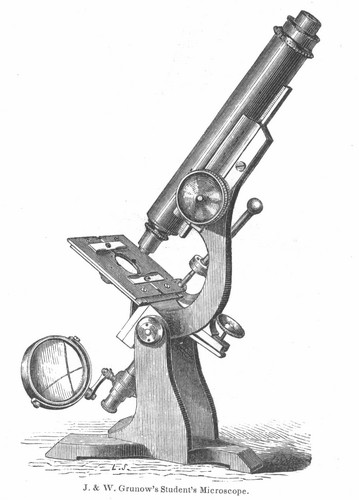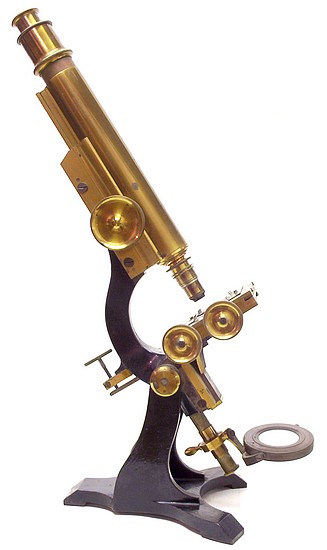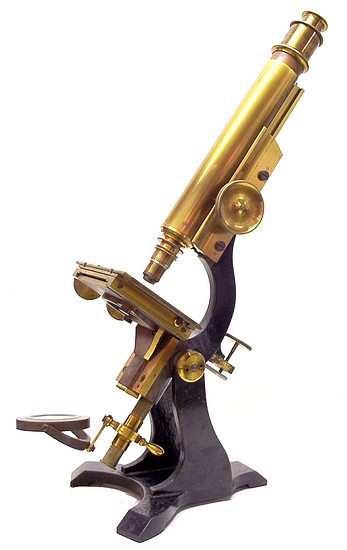The following was
extracted from the Illustrated Scientific
and Descriptive Catalogue of Achromatic Microscopes
Manufactured by J. & W. Grunow & Co., New
Haven, Conn, 1857

The Student's
Larger Microscope. Shown in figure 10, is made of
the dimensions agreed by microscopists as the most
convenient for general use, and fitted for the
application of accessory apparatus of such dimensions
as to secure their greatest desirable efficiency. The
tripod base is large and strong made of japanned
cast-iron, giving firm support and freedom from
tremor. The coarse adjustment is performed by rack
and pinion, by turning a large milled head,
conveniently placed; the body moving steadily in a
long grooved support, and being retained in any
position by springs. The fine adjustment of the focus
is performed by a screw acting upon a lever, which
gives to the stage a delicate upward movement. Two
sliding clips retain the object on the stage.
The stage, which is
three by four inches, is so constructed that it can
be moved smoothly and steadily in every direction,
the object appearing to follow the motions of the
stage upon the lever. This movement of the stage
gives great facility for tracing every part of the
slide in the search for delicate objects, and enables
the observer to follow with ease the motions of
living animalculae, even with high powers. Beneath
the stags is circular plate carefully centered and
adapted for receiving accessory apparatus.
Two mirrors, plane and concave (the latter two
inches in diameter), are so mounted as to have a free
and steady motion in every direction. By means of an
arm, the mirrors can be thrown far out from the axis
of the microscope to give very oblique light for
illuminating the object.
This instrument has a
graduated draw-tube, by which the distance between
the objective and eyepiece can be considerably
increased. This increased length produces a
proportional increase of the magnifying power, and
thus often greatly aids in ascertaining the value of
micrometer graduations*
Stage Movable
by Rack and Screw. American microscopists generally
prefer our form of stage, movable by a lever. The
instruments that we keep on hand are, therefore,
usually furnished with this form of stage. But we are
accustomed to make to order a stage movable in
two rectangular directions by rack and screw.
* This instrument is
often made with a plain stage, which considerably
reduces the expense. It can also have added the
revolving motion of the stage, as shown in the next
figure. Bailey's Indicator Stage can be applied to
this instrument, if desired, instead of the stage
here shown. The use of cast-iron, for the base and
arm of the preceding instruments, has been adopted to
bring the prices within the most reasonable limits.
This arrangement does not, in any manner, diminish
the efficiency or beauty of the instruments. The
parts made of iron are carefully smoothed and neatly
japanned, and give a pleasing contrast of color with
the other parts, which are of brass. But when
specially ordered the base and arm are also made of
brass, at a reasonable addition to the price.
This
microscope dates from around 1855. The Grunow
brothers, Julius and William, emigrated from Germany
to New York around 1849. They started in the
scientific instrument business by first working for
the optician Benjamin Pike of that city. By
1854, they began their own operation in New Haven CT
where they concentrated on the production of
microscopes. By 1864, they were back in New York.
Some years later, the partnership ended. J. Grunow
continued on to produce microscopes up to around
1892. The total output of the Grunows was limited in
comparison to some other contemporary firms; on the
basis of the observed serial numbers, they
manufactured just over one thousand microscopes in
total.





